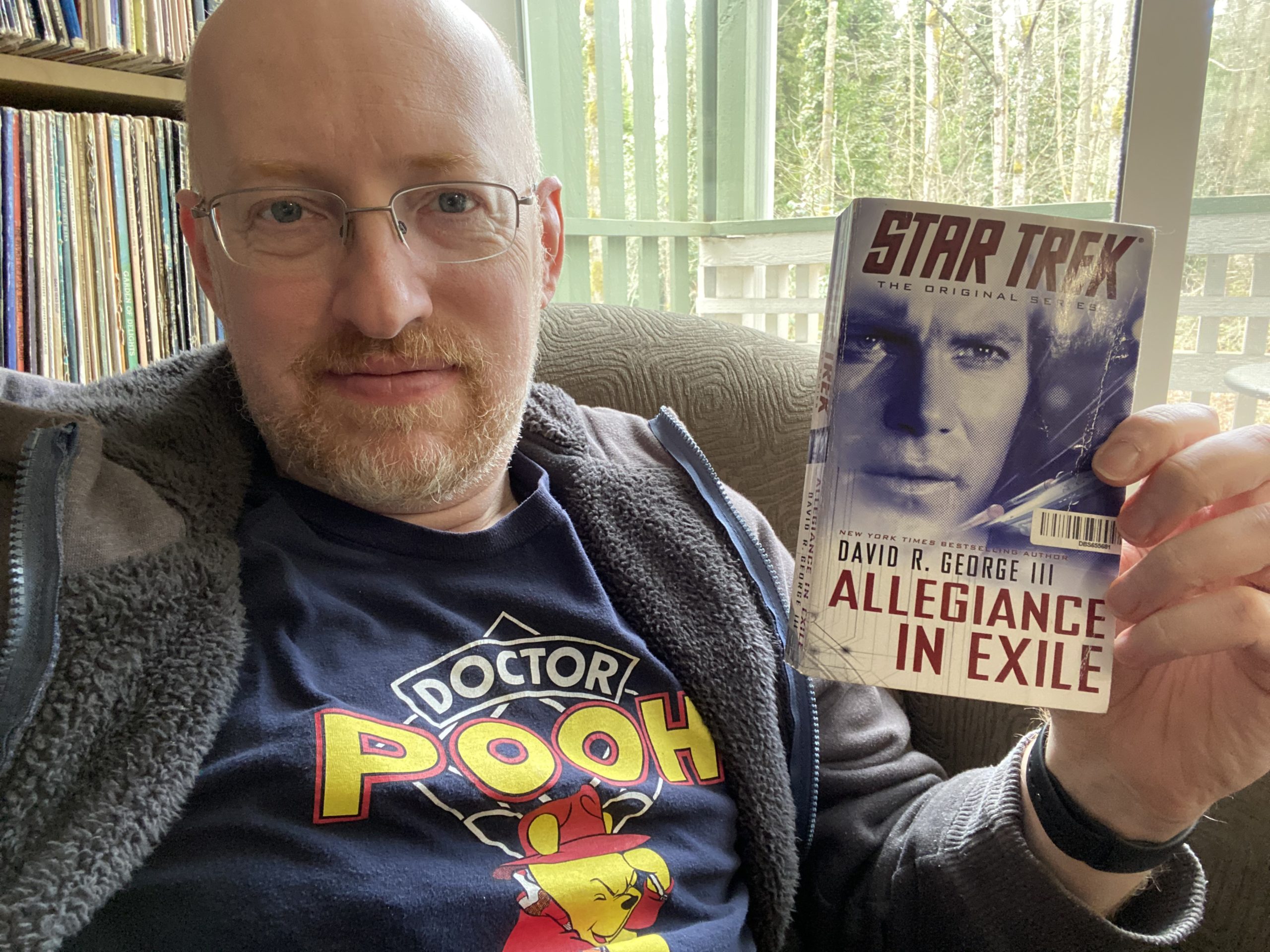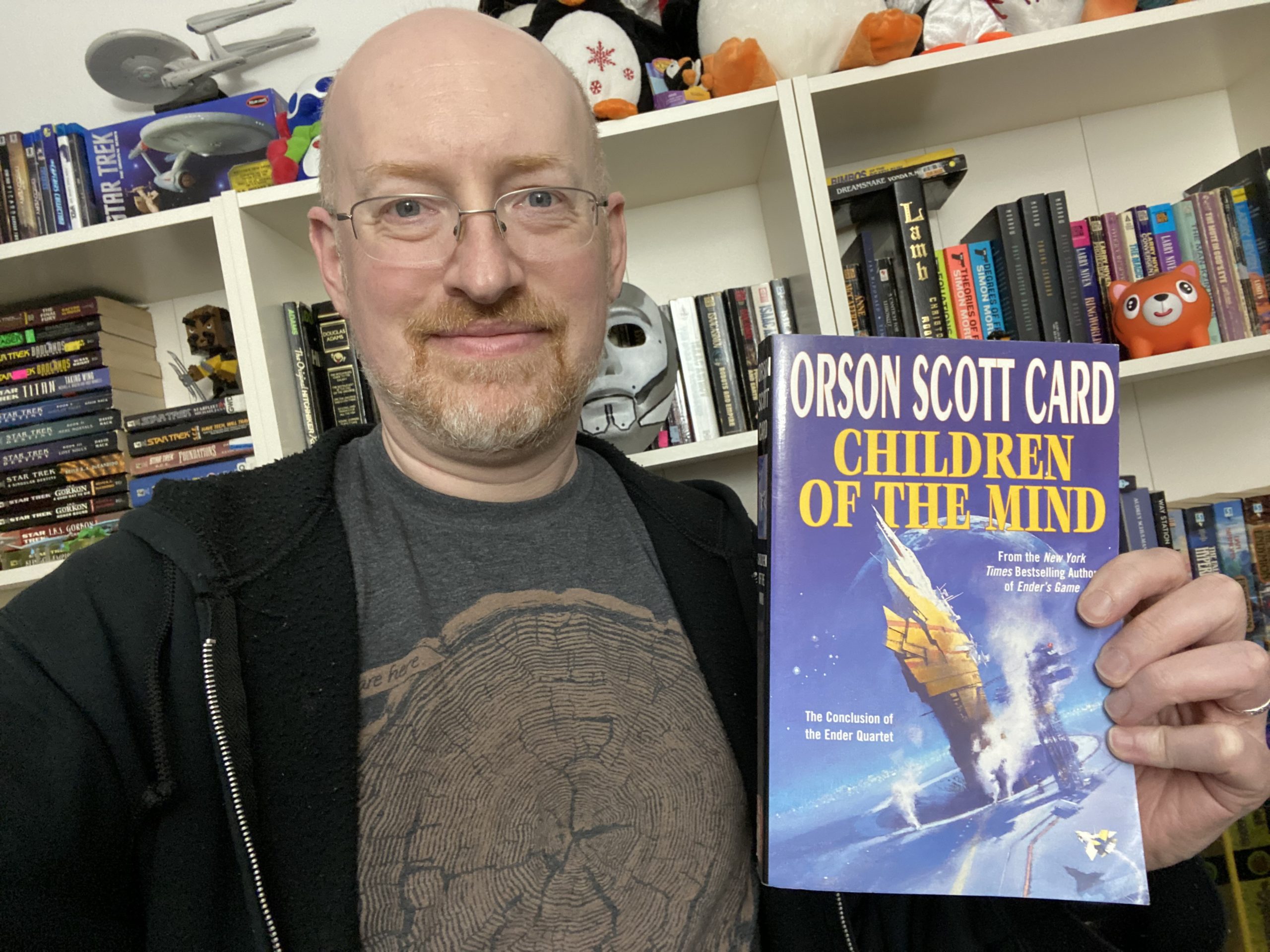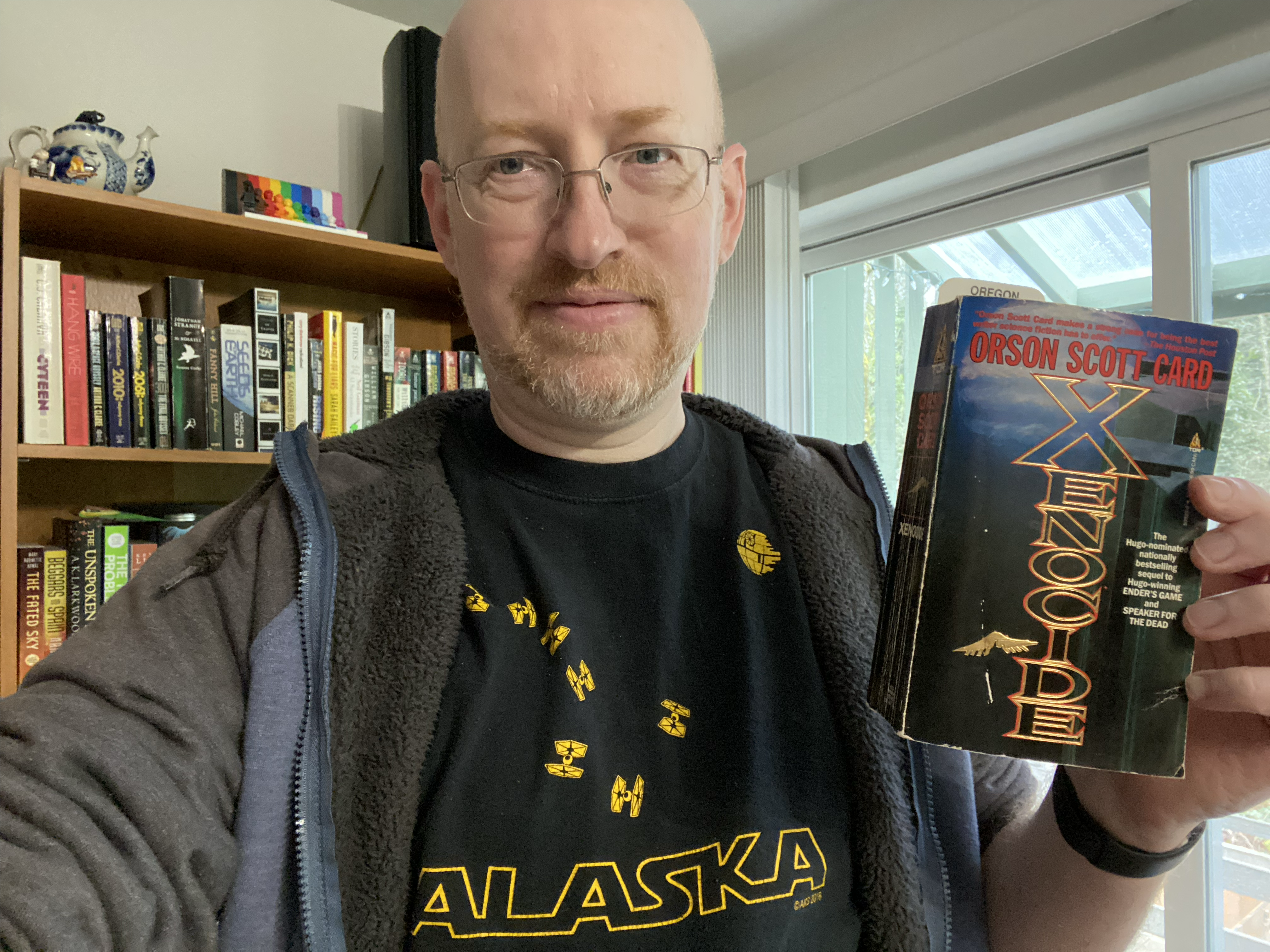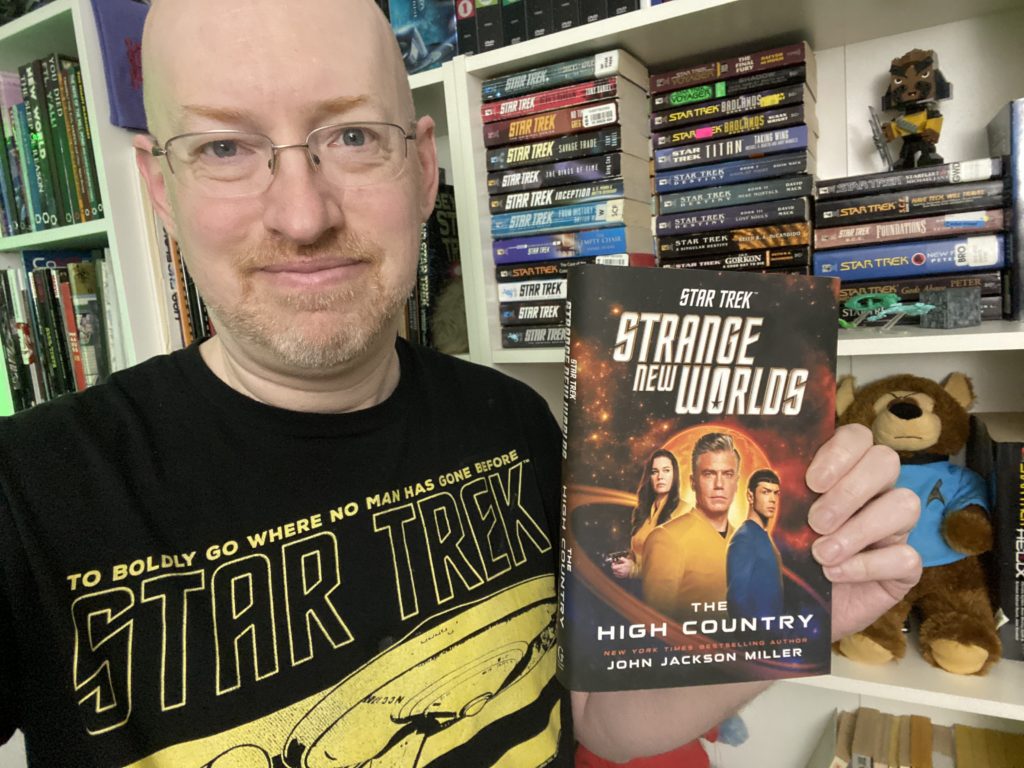Recorded live on Thursday night at Norwescon 45: After opening ceremonies, get moving at the Multiverse of Music with DJ Wüdi, spinning dance tunes crossing decades, styles, and genres with something for everyone. From con standards to pop hits, dance floor classics to modern mashups, new wave to dark wave, enjoy an evening of eclectic tunes chosen to keep the dance floor moving.
Difficult Listening Hour 2023.04.02
Another session of practicing with my mobile setup. Mostly pop/new wave, some electronica, started with the ’80s and moved into the ’90s. The usual random selections.
Difficult Listening Hour 2023.03.26
Another session of practicing with my mobile setup. Stuck pretty close to 130 BPM for this set, just pulling some of my particular favorite tracks out.
📚 Allegiance in Exile by David R. George III
19/2023 – ⭐️⭐️⭐️
Not quite what I expected. There’s a pretty standard Trek adventure as a framing story (with a surprising connection to post-TOS Trek that I’m curious about), but it’s really more focused on Sulu and his having to deal with a tragic event. Not bad, just be aware the back cover blurb is a very small part of the actual plot.

📚 Children of the Mind by Orson Scott Card
18/2023 – ⭐️⭐️⭐️
Not the strongest book in the series, but with a series this strong, that’s not at all a bad review. A good end to Ender’s story, and wraps up the various pieces in satisfying ways.
(That said, see my earlier disclaimers on OSC and his works. Extremely good writer, but one with rather unfortunate beliefs. While I’ve enjoyed reading through these, it’s time to move on to other authors for a while.)

Difficult Listening Hour 2023.03.20
Just a short 30-minute practice set as I get used to using a mobile (laptop-based) setup instead of my home (iMac-based) setup, and to incorporating Beatsource as a track source instead of solely relying on my own library.
📚 Xenocide by Orson Scott Card
17/2023 – ⭐️⭐️⭐️⭐️
This series continues to impress, with ever deeper explorations of compassion and empathy for others who are different than ourselves, and at what point the differences become so great that life- and world-altering decisions may be justified (or may not be, or may be pursued even if not justified). And once again, I’m struck that an author who wrote so compellingly on this subject failed to see how to apply his own ideas in the real world.
NOTE: It should be noted that OSC had long held and promoted viewpoints that I vehemently disagree with. The books of his in my collection were purchased before I knew of his standpoints, from secondhand stores, or both. I knew going into my Hugo reading project (which this is an extension of, though the later books in the series weren’t Hugo winners) that there would authors and works I would find problematic, and that there might be situations (like this one) where I enjoyed a work by a problematic author. I do what I can to mitigate those situations by purchasing used copies of books so as not to directly contribute to those problematic authors who are still with us, and by noting when I run into those situations – like here.

Still Doing This For Fun
From I don’t want to log in to your website:
I was on the internet in the 1990s, and I remember when people just made stuff for fun — as a gift to other people. It seems like there’s less and less of that spirit remaining, and it’s why the internet sucks now. It’s why I have to append “reddit” to my Google searches to avoid getting SEO glurge — the for-profit stuff drowns out everything else. It’s why people are using DALL-E for newsletter header images to make sure their newsletter gets a bigger card in a social media feed — because it doesn’t matter what the image looks like as long as it exists. It’s why people intentionally put errors in their TikToks to juice engagement — because all the people commenting to tell you you’re wrong boost you in the algorithm. This is the bad place!
In a lot of ways, I miss the ‘net of the ’90s. But I’m still here, doing my part, without any annoying login popups. I may not post as much as I once did, and the majority of it may be my short little book reviews, but at least I’m still going, and working on posting more regularly again. I figure I’ll keep doing this as long as I can.
📚 The High Country by John Jackson Miller
16/2023 – ⭐️⭐️⭐️⭐️
A fun, light romp of an adventure, rather perfect for the first Strange New Worlds book. Several Enterprise crew are stranded on a world where electronics don’t work and technology is tightly controlled. This results in a mishmash of the Wild West, mountainside castles, tall ships, mysterious aurora, and steampunk-ish clockwork creations. All with a welcome dash of humor throughout. I enjoyed this one a lot.

Induction Ranges are Magic
Our oven/range died at a few weeks ago, and when we replaced it, we decided to go with an induction range (an IKEA Tvärsäker). Though we hadn’t used an induction range before, we’d done some reading and some research, and everything we’d heard sounded pretty enticing, so we decided to give it a shot.
Short version: That was a really, really good decision.
First off, induction heating is just cool. Something something magnets and magic is how it works, but it means that instead of a heating element getting hot and transferring the heat into the pot, with this, there’s no heat generated from underneath: the pot just gets hot. The only heat the range surface gets is whatever it absorbs from the pot that’s sitting on top of it, so it never gets as hot as a normal range, and it cools off faster because it didn’t generate the heat. And if you do accidentally let something boil over, because it’s not landing on a super-hot burner, it doesn’t get cooked onto the range top, making cleanup a lot easier.
Heating is much more consistent. Our old range would constantly cycle the coils up and down, never settling on a consistent temperature. With this one, whatever setting you have it at is what it’s at, making it very easy to keep things at a good regular simmer or boil or whatever you need.
And it’s fast. The burners have the normal 1-9 settings, “H” for “high”, and then a “P” setting that apparently means “power boost”, that will only run for a maximum of 10 minutes, but I can’t imagine what would need that level of power for that long. That setting will easily get a teakettle boiling in just a minute or two. It’s really neat.
It is slightly noisier: The burners produce a buzzing sound that increases with higher power settings and can also make the cookware buzz a little bit from the magnetic fields. However, while it’s very noticeable at first, it’s not so loud as to be intrusive, and we’ve found it very easy to get used to.
Plus, induction ranges are more energy-efficient and environmentally friendly than standard electric or gas, so that’s nice too. If you’re looking for a new range, we’d definitely recommend going with induction.
Also, though it wasn’t one of the first places we looked, based on this experience, we’re very happy with going through IKEA when appliance shopping.
The oven died on a Friday at the end of January, so we went shopping on Saturday.
Lowe’s: Didn’t have quite what we were looking for, the salesperson was bad (my wife told him what she was looking for, he proceeded to only speak to me, and then walked us over to something that was what she specifically said she didn’t want).
Home Depot: Didn’t have quite what we were looking for, and even if we went for the best possible match, it would have been the end of February before it got delivered.
As we were heading home, my wife had a sudden thought: Doesn’t IKEA sell appliances?
Went to IKEA. They had what we were looking for. The salesperson was good. They apologized that because we wanted to have the old range hauled away, they had to use a different company to do the delivery and pickup, and so it would take a little longer — so the delivery would be that Monday. Y’know, three days after making the purchase.
That Sunday we got a text giving us a delivery window of 4-8 p.m. on Monday. Monday at 10:30 a.m. we got a knock on the door — they were early, by at least six hours.
And a few minutes later, we had a big, heavy cardboard box in our dining room. (Unsurprisingly, IKEA doesn’t do full installs. And there was some assembly required — attaching the power cord and the door handles.)
Later that day, we got everything assembled and put in place, and did the first test batch of cookies. Success!
Four days from failure to replacement with good service? We’re pretty happy with that.
